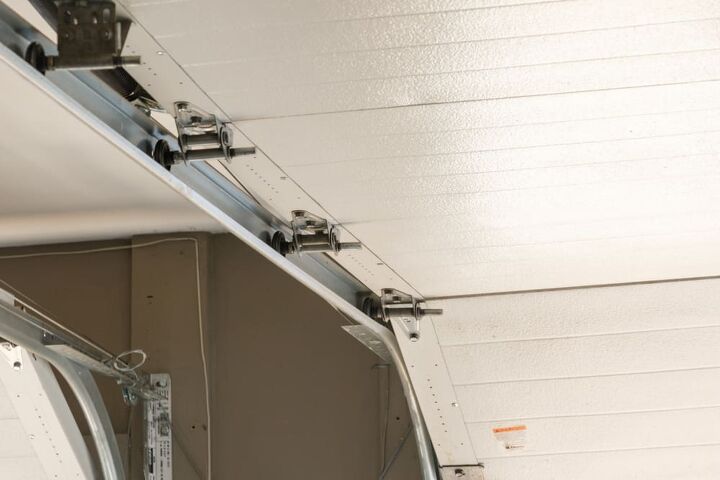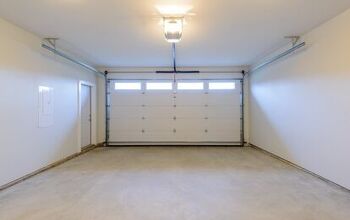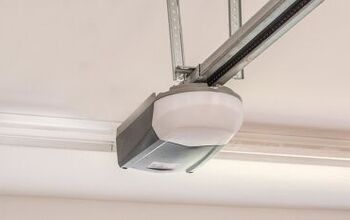How To Fix A Garage Door Cable That Is Off Track (Do This!)

If you have had your garage door for a long time, you are familiar with the cables. After years of use, cables can become rusty or damaged, causing them to go off track. This can put a strain on other elements of the garage door, like the springs or rollers.
If your garage door cables come off the track, they are probably corroded. The corrosion can happen due to water and salt exposure or excessive rubbing against other parts. When this happens, you should replace the cables.
Do You Need a Garage Door Repair Service?
Get free, zero-commitment quotes from pro contractors near you.

Purpose of a Garage Door Cable
You can find garage door cables on both sides of the garage door. The cables attach to drums with tracks that wrap and unwrap the cables. With the help of springs, they move the garage door up and down smoothly.
If the cables break or come off the track, the door won’t lift evenly.
Step-by-Step Guide to Fixing a Garage Door Cable
After years of use, you can end up with damaged garage door cables and need to replace them. Before you replace the cables, make sure you purchase the correct type for your garage door. Cables come in a variety of lengths, weights, and types.
You can replace garage door cables in a few easy steps.
Tools You Need for the Job:
- A flathead screwdriver
- Replacement garage door cables
- Vise grips
Step 1: Open the Garage Door and Clip the Cable
To begin the repair, open the garage door and clip the cable in the track to secure the door. You don’t want the door to be able to move.
Step 2: Secure the Vise Grips
Secure the vise grips just below the bottom of the garage door to prevent the doors from dropping. Then, secure the vise grips to the cable shaft’s outer end and pull in a counterclockwise motion. This will release any tension on the shaft.
Pull the shaft just enough so that the cable is loose. Do not pull too much or the cable will unwind and tangle.
Step 3: Remove the Cable Loop and Unwind
Use a flathead screwdriver to slide behind the loop and remove the cable from the garage door. Unwind the cable and remove the end of the cable from the slot in the pulley gear.
Step 4: Install the New Garage Door Cable
Open the new cable from the package. One end has a loop, and the other is straight. Bend the straight end to a 90-degree angle. Slide the bent end into the notch on the pulley. Use a flathead screwdriver to push the cable into the center of the gear.
Step 5: Wind the Garage Door Cable
Wind the garage door cable counterclockwise around the pulley until about 12 inches are left. Slide the loop end of the cable over the connector.
Step 6: Tighten the Shaft and Remove the Vise Grips
To complete the installation, tighten the shaft by turning it counterclockwise. Make sure that the garage door cable is inside the groove of the pulley when doing this. Tighten until you remove all the slack from the cable, then remove the track’s vise grips.
Reasons Why the Garage Door Cable Is Off Track
There are several reasons the garage door cable can come off the track. Take precautions when installing the garage door and make sure to inspect for any wear or damage regularly.
Excessive Manual Lifting
Most homeowners choose to have automatic garage door openers. However, some garage doors require manual lifting to open and close the door. This means continually picking up the door off the ground to open and pulling back down to close.
An opened garage door should rest between zero to three inches in the opening. This means that the bottom of the lowest section of the door is visible when fully open. If you raise the door too fast, the cables can slip off the drums.
Corrosion
If you have a residential garage, there is usually a controlled climate. However, if you live in extreme environments, your garage door could become damaged. If your garage door is regularly exposed to salt and water, it can weaken the door and garage components.
Corrosion occurs when moisture interacts with refined metals. This can lead to rusting, which will severely weaken the metal. This usually happens at the bottom loop end of the cable since it’s closer to the ground.
If corrosion of the cables does occur, the cable can eventually break and damage the door and anything underneath it. If you live in this type of climate, regularly check for rust buildup. Consider using higher quality cables that are zinc-aluminum coated and have a thicker diameter and higher thread construction.
You Set the Door on an Object
A common reason cables come off the track is because you may repeatedly set the garage door on top of an object. The object may not be noticeable as it can sit six inches off the ground. These objects can be broom handles, chairs, or tools.
When this happens, it creates uneven weight distribution and slack in the cables on one side of the door. The slack can cause the cable to come out of the drums’ grooves, causing tangled cables and damage.
Wrong Cable Drum
Cable drums work with specific diameters and lengths based on the cable. They also have particular track configurations based on the cable. The standard residential garage door lift drums are compatible with doors eight feet tall and 525 pounds.
If you install the wrong size or type of drum, the cables will come off the drum. If the cables are too small or too large, they will slip out of the grooves.
Broken Extension Springs
You can find broken extension springs stretched along the horizontal tracks. When the garage door is open, the springs are in a relaxed position. They add tension to the door as it closes using gravity.
When the garage door is opening, the springs stretch to release tension and help the door rise. If one of the extension springs breaks, the cables can unwrap and become tangled around the pulley. If this happens when the door is closed, you’ll see slack in the cables and a loose spring hanging down.
Broken Torsion Springs
If the torsion springs break, the garage door can fall. For this reason, you should install two springs. The purpose of the second spring is to keep tension in the cables until you can repair the door.
If there is no second torsion spring, the slack in the cables can slip out of the grooves if it should break.
Frayed Cable Components
Fraying can be the cause of cables coming off track. Fraying is caused by the cable components rubbing against an object on the garage door repeatedly. When the cable threads start to fray, it can add stress on the other threads and cause them to snap.
Cables can rub against the edge of the door, brackets, track, or plates. Make sure to inspect the cable and garage door for signs of damage or friction. Cables usually snap at the bottom of the door.
Wrong Cable Strength
Your garage door cables should be the correct strength. You can determine the right strength by assessing the cable diameter. A thicker cable means a higher minimum breaking strength. The cable thread material can also influence the strength of the cable.
Using a small diameter cable on a heavy door will cause the cable assembly to fail. If you have a residential garage door, you can use a ⅛ inch diameter cable. The drums and lift cables should be rated for at least 500 pounds for residential garage doors.
Uneven Garage Door Installation
If your garage door was not installed correctly, it could lead to loose and uneven tension. When installing cables, make sure that the tension is relatively even on each side of the door. If one cable drum is tighter than the other, the opposite side will unravel.
The same situation applies if you install a garage door on an uneven surface. If your driveway is sloped, you may need a universal aluminum retainer to attach to the bottom of the door. If not, one side of the door will hit the concrete first and cause slack on the other side.
To determine if the garage door is level, turn out the lights and close the door. If you can see light under one side of the door, it could be unlevel. You can also check the bottom of the door for excessive wear or flattening on one side.
Do You Need a Garage Door Repair Service?
Get free, zero-commitment quotes from pro contractors near you.

Related Questions
How often should I get my garage door serviced?
You should get your garage doors serviced once a year if there are no other issues. By doing preventative maintenance, it will prolong the life of the garage door. In between regular maintenance, you can do small things to keep your garage door in good condition. Be sure to lubricate garage door hinges and tighten bolts and screws. If you feel comfortable doing so, you can also adjust spring tension.
What is the average price for a garage door installation?
The price of garage door installation will depend on the type of garage door you choose. Garage door installations can range from $730 to over $10,000. The average cost is about $1,100. If you do decide to replace the entire garage door, contact a professional. They can guide you through the process and install the door for you.

Stacy Randall is a wife, mother, and freelance writer from NOLA that has always had a love for DIY projects, home organization, and making spaces beautiful. Together with her husband, she has been spending the last several years lovingly renovating her grandparent's former home, making it their own and learning a lot about life along the way.
More by Stacy Randall



























